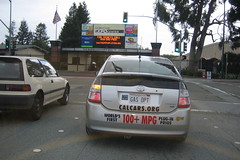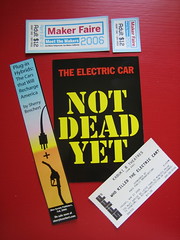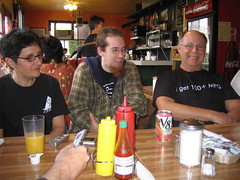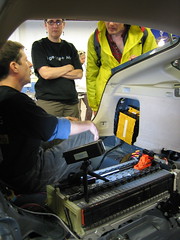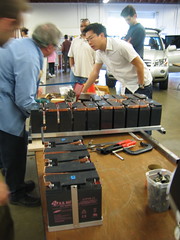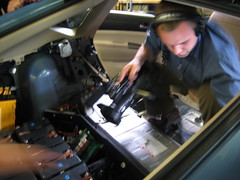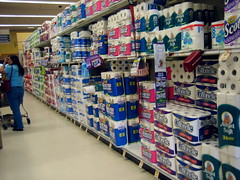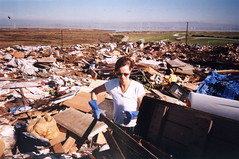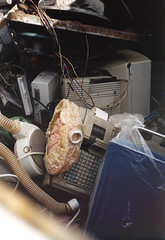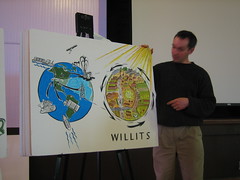Make Faire Plug-in Prius Demo
When Felix Kramer of Cal Cars called to ask me if I was handy with tools, naturally I said yes. As soon as he described the project he had in mind I knew we were about to make automotive history. He wanted to do a public conversion of a stock Prius into a plug-in Prius with a handful of home mechanics over the Earth Day weekend. And he wanted women on the team. I didn't need to be asked twice.
I had met Felix when he came to a meeting of the San Francisco chapter of the Electric Vehicle Association to show us the world's first plug-in Prius. After that I kept running into him dressed in suit and tie at various green transportation events and lectures, handing out literature and being the first one to stand-up during the Q & A to ask the "expert" why we weren't using existing technology such as the plug-in Prius. He was a natural publicist with the added advantage of being tall and professor like. I soon began to see his name in newspaper and magazine articles popping up everywhere touting the plug-in hybrid technology.
In the electric vehicle community, the hybrid car is not really our cup of tea. The technology, we feel, is overcomplicated, expensive and cumbersome in its attempt to be everything to everyone. However we embraced the hybrids because it did, after all, still have an electric motor on board and it was a commercially available production car. When the plug-in concept came along we jumped to promote the missing piece - the plug.
If the public was so resistant to the alien technology of an all-electric car, the hybrid would be the training wheels; the back-up safety net that would ensure nobody would be stranded. Once hooked on the stealth mode of the electric motor and the ease with which it could use the cheaper power from the electric grid, we knew these car owners would be hooked. Gas prices were only going to yo-yo to ever higher numbers as oil supplies diminished, not to mention the increasing threat of global warming and the long term tragedy of going to war over oil.
To attempt a two-day conversion in a public venue was ballsy to say the least. We had never worked together, all of us; we did not even meet everyone until the morning of the event at a breakfast cafe. I sat across from the owner of the Prius going under the knife. He was young with long hair and a goatee; an EV enthusiast who had bought his '05 Prius nine months ago after he had seen the plug-in option could be done. He was looking a little nervous, but would soon prove an eager mechanic, overseeing every step of the process.
Sitting next to him was Sherry Boschert, who's book, Plug-in Hybrids: The Cars that will Recharge America would be coming out near the end of the year. We also had, on the team, a married couple from Santa Cruz who sold kits to people wanting to convert their cars to electric, the lead engineer from the original conversion, the president of the Seattle EV club who had done his own conversion project, a Silicon Valley engineer, a fellow activist who put together the Plug-in America site, a jeweler who sold solar power systems and would lead our project and a Toyota mechanic who had been helping the team by scouting out the odd part from Toyota and copying, for them, nearly the entire Prius shop manual.
"This may not work", Felix cautioned us. "I don't want you to give the impression that this is a sure thing. It may turn out that it isn't even worth it." Yes, the important thing was that we were doing it at all.
Arriving at the San Mateo Fairgrounds, we met the camera crew. The project would be taped from start to finish by two professionals. As activists, we had learned from the history of the electric car and its demise that the media could not be relied upon to inform the public of innovations that might upset the combustion engine status quo.
We had just seen the new documentary "Who Killed The Electric Car" which by complete coincidence was showing the night before, at the San Francisco Film Festival. This tale, of GMs much loved EV1 being sent to the crusher despite the popularity of the car and the horrified cries of those who wanted to keep it, was a neat summary of how corporate power, in collusion with government and oil interests, squelched any innovation threatening to their hegemony. The plucky, democratic, American can-do spirit, that we are counting on to solve our planetary problems, was clearly being trampled. Audiences come away outraged and wanting to do something. The film, distributed by Sony Classics, will open on June 28th in a handful of major cities. With a bit of luck it will build on the buzz it is already getting.
Once the cameras were rolling, Tom, our team leader went into hyper drive pulling out the storage compartment above the spare tire, the tire itself and the surrounding interior housing. He gave out assignments to cut plexi-glass, hammer copper tubing, splice wires and assemble components. With twelve on the crew, we had plenty of hands; enough to assure that there would always be someone to answer questions from the public.
And who were these people I wanted to know? After cutting some plexi-glass pieces, I went to investigate. This was the inaugural Maker Faire, sponsored by Make Magazine, a new quarterly. Advertised as a celebration of do-it-yourself ingenuity, it was part science fair, part craft fair. At first glance the fair appeared to be filled with pyrotechnic displays, ax wielding robot tanks and homely wooden bicycles that defied logic or the rider to ride them. It seemed to be the anti-thesis to my green festival, solution-oriented sensibilities.
Why were these people spending their creative energy making these inane toys? Where were real world solutions to our dire problems? I regained my sense of humor upon seeing the rubber chicken catapult and the laxative propelled dildo drag racer; the faire began to speak to my inner geek. Heck wasn't it great that people, especially kids, were absorbed in making something instead of shopping? Whether it was a propeller driven boat made from plastic bottles and aluminum cans or a sibling intruder detector, the Maker Faire was bringing alive the human desire to create and solve problems.
The magazine itself was largely ad free with a question authority flavor about it. It embodied the Maker Bill of Rights, a document demanding that all the annoying design elements of consumer products that would quickly deem the item trash should be abolished. Tamper proof enclosures, for instance, or special tools and non-replaceable batteries that made the product difficult or impossible for the owner to repair it.
"If you can't open it you don't own it" was the slogan on the t-shirts.
There were no tamper proof enclosures on the Prius, but the warranty violation was enough to deter most owners from hacking into it as we were doing. Not this crowd though. Only a few asked if we would void the warranty. For the computer and electronics maybe, but not for the rest of it, we told them. What the owner would sacrifice was access to the spare tire as the new batteries would sit on top of the spare tire wheel well, but the cargo space would still be the same.
What people did ask was "why wasn't Toyota doing this?" Our makeshift set-up was so obviously inferior to the resources and brains of a modern automotive factory. And with no access code, we were having to "spoof" the computer, fool it into accepting the new battery pack without shutting off the electric mode and turning on the gas engine. When I told people that Toyota didn't think the public would understand the concept or accept a plug-in option, they rolled their eyes. This was a crowd eager to jump on every new innovation.
The auto industry has many excuses, but we believe that what they fear most is that the electric motor technology would suddenly switch the entire industry over to this superior technology just as digital cameras had rendered film cameras obsolete. The combustion engine, with all its after market servicing needs, would be gone and oil profits with it. Toyota claims that battery technology is not here yet even for a plug-in hybrid, but we know that they made the RAV4 EV with a range of 100 miles using the nickel metal hydride battery (NiMh).
The battery pack being installed into our project were small lead acid batteries used in motorcycles and electric bicycles. They were cheap and available, but would only have a range of 20 miles and would add 300lbs in weight. (I spent a good part of the weekend hammering lengths of copper tubing flat and shaping them into connectors to bolt to the battery terminals, thus forming an electrical path between them.)
The lighter and better performing NiMh batteries are only sold in large lots suitable for mass production. Since an oil interest has a controlling stake in the company that makes them, we suspect that this is an effort to keep home mechanics from building viable electric vehicles. The new hope was in lithium ion batteries. Though expensive, these batteries, in an electric car, would boost performance beyond the combustion engine altogether. The car companies had no excuse.
What we were trying to do was show the public that the technology was here and create a demand for it. Many visitors to the booth thought we were in the business of installing the option ourselves and were annoyed when I told them this was just a demonstration and the only U.S. company able to give them the plug-in option would take 6 months to install it. For about $3,000 in parts they could do it themselves, but what we wanted them to do was go to their dealer and ask for the plug-in option, thus letting Toyota know that we had let the cat out of the bag and consumers were demanding it. Such are the visions of the grass roots activist.
On Sunday CNN showed up. Felix had been talking to the press tirelessly all day and now we couldn't find him. An urgent call was made to his cell phone and I answered the reporter's questions until he showed up. The press had been covering the fair all weekend and the Seattle EV president had already been on Channel 5, Saturday night, delivering our message.
Sunday morning we started seeing reporters and cameraman early in the day. One reporter said that he particularly wanted to find us because we were the only exhibit doing something that was actually useful. Bing, bing, bing. Jackpot. Yes this was what we had wanted to achieve. Never mind that the project would not be finished by the end of the fair. (The crew would stay late into the night, then drive the car to another location where they would continue to work on it all day Monday to ensure the car was operating with the new battery).
To wrap up our demo we did a mock installation of the battery pack for our camera crew, followed by a group photo and cheer. We were happy to act out this triumph for now it was documented and would serve to show that we had tried. We had defied the powers that be and shown that ordinary citizens could bring forth real solutions to real world problems.
